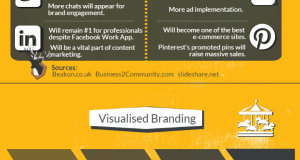When you think about major healthcare system players does the name IBM come to mind? Probably not, but maybe it should at least as we move into the future. Four years ago Big Blue opened a department on life science to develop the growing market for high-power computing in research. Now they’ve consolidated it with their medical care branch, and, combined, they employ thousands of scientists and health care experts—in addition to all the programmers, etc.—to develop what they see as a major opportunity.
Their vision of the near-term future of the healthcare system spelled-out in a paper called: “Personalized healthcare 2010: are you ready for information-based medicine?” is a pretty good roadmap to how information-intensive medicine is going to change research and medicine well within the 2015 window of interest to ACS. Sure it’s a marketing vision, but I don’t think it’s too far off the mark. Here’s some of what it says.
Information-based medicine is the marriage of information technology with the practice of medicine and pharmaceutical research, for improved disease diagnosis, therapeutics and healthcare delivery. Simply, information-based medicine is the use of information technology to achieve personalized healthcare.
Societal changes, along with disruptive technologies in medicine and information technology, will impact pharmaceutical and healthcare institutions, thus creating new business models and methods in healthcare and impacting every person’s day-to-day life. It is anticipated that these disruptive technologies will enable the following predicted changes by 2010:
1. Medical science breakthroughs will become increasingly common, due to increasing consumerism.
2. Genetic testing will be routine for some population groups, and associated privacy and discrimination policies will be determined through a broad debate involving government, industry and citizens.
3. Several major diseases will be understood at the molecular level, including relevant proteins and pathways, with clearly understood disease mechanisms.
4. Some subpopulations at risk for adverse drug events will be identified for many therapeutics, resulting in increased drug discovery productivity and targeted clinical trials.
5. Healthcare will become wellness care, making presymptomatic diagnostics and treatments commonplace.
I bolded the last item because it is in line with the hope that as health information becomes more specific to individuals it will allow earlier diagnosis and have more motivational power for prevention.
As more and more prospective patients enter the market, pressures from consumers, employers, healthcare providers, payers and regulators will increase and drive the shift toward data integration and knowledge management in the development of diagnostics and therapeutics. Medical science breakthroughs driven by consumerism will be influenced by these trends. The authors of “Thinking About the Future” voiced this prediction in 2001, “The combination of demographic shifts and cost pressures and a flood of new technologies – both biological and digital – promise that the new century and the coming generation will see the creative destruction and rebirth of what we know today as health care.”
This is a rather optimistic estimate that all this is going to straighten out the health care system—calling it a “system” right now is really stretching the concept. It’s a kluge.
Concerns about privacy and security of health information might lead to an interesting new idea, “biobanks.”
There is a trend in the healthcare standard communities to give the patient ownership of his or her medical data and thus move the control of the information from the institute to the patient. This trend may lead to the need for “BioBanks,” which will be trusted entities that mediate among healthcare organizations, patients and research institutes.
In other words, if you don’t trust your health care plan or the government to hold your personal health information you would deposit it in your account at a biobank, a secure repository of information the way banks today hold money. Presumably if anybody wanted access to the information you’d be able to set rules and you’d get a report. Who’d like to do that? Yeah, IBM.
Does all this apply to cancer? Well, the report cites an NCI project, caBIG, as an example of what they’re talking about.
The National Cancer Institute (NCI) announced its intention to create a cancer-based biomedical informatics network, called the Cancer Biomedical Informatics Grid (caBIG). The goal of this effort is to build a biomedical informatics network that will connect cancer research-related elements of data, tools, individuals and organizations and leverage their strengths and expertise globally. caBIG will help redefine how research is conducted, care is provided and patients and participants interact with the biomedical research enterprise.8 Participation in this kind of network – based on universal standards for information security and ethical use – means that all stakeholders must adhere to strict security measures for accessing, utilizing and transmitting patient data.
 501derful.org
501derful.org



